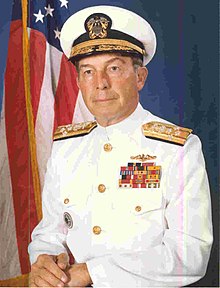Robert L. J. Long
Robert Lyman John Long | |
|---|---|
 Admiral Robert L. J. Long | |
| Born | May 29, 1920 Kansas City, Missouri |
| Died | June 27, 2002 (aged 82) Bethesda, Maryland |
| Allegiance | |
| Service/ | United States Navy |
| Years of service | 1943-1983 |
| Rank | Admiral |
| Commands held | USS Sea Leopard USS Patrick Henry USS Casimir Pulaski ComSubLant Vice Chief of Naval Operations United States Pacific Command |
| Battles/wars | World War II Vietnam War Cold War |
| Awards | Navy Distinguished Service Medal Legion of Merit Bronze Star |
Robert Lyman John Long (May 29, 1920 – June 27, 2002) was a four star admiral in the United States Navy who served as Vice Chief of Naval Operations from 1977–1979 and Commander in Chief Pacific from 1979 to 1983.[1][2][3]
Early years and education
Long was born in Kansas City, Missouri, and grew up there. He was the son of Trigg Allen and Margaret (Franklin) Long. He attended Paseo High School, Kansas City Junior College, and Washington University in St. Louis, Missouri, before enrolling at the United States Naval Academy.
Long graduated from the Naval Academy in 1943, served on the battleship USS Colorado in the Pacific and entered the submarine service after World War II. He saw combat in the Vietnam War and commanded the USS Sea Leopard, a diesel-powered submarine, the USS Patrick Henry and the USS Casimir Pulaski, nuclear-powered ballistic missile submarines.
He also commanded the Submarine Force, United States Atlantic fleet; Submarines, Allied Command; and Submarine Force, Western Atlantic area. He was executive assistant and naval aide to the under secretary of the Navy; deputy chief of naval operations and vice chief of naval operations.
Long's final Navy posting was as Pacific Commander in Chief.
Following his retirement from the Navy in 1983, Long was active in a variety of governmental and the military affairs. He served as the principal executive of President Ronald Reagan's fact-finding committee, the Long Commission, that investigated the 1983 Beirut barracks bombing attack that killed 241 U.S. Marines. The Commission's report was widely praised for being tough and direct. The report found senior military officials responsible for security lapses and blamed the military chain of command for the disaster.
Long participated in the Security Review Commission led by General Richard Stilwell that grew out of the Walker spy case and which was tasked with review of security procedures conducted for security clearances. He was a member of an American election observer team sent to the Philippines in 1986 and headed by Senator Richard Lugar to observe the Presidential election contest involving Ferdinand Marcos and Corazon Aquino. Long was teamed with the then first-term senator from Massachusetts John Kerry. He joined the Defense Policy Board in 1984, and was a part of the Advisory Committee on Command and Control of Nuclear Weapons, chaired by Jeane Kirkpatrick.
Long served as President of the Naval Academy Alumni Association from 1991 to 1994.[4] He also served on several corporate boards, including Northrop, ConTel and GTE.
Personal life
Long married Sara Katherine Helms on August 28, 1944, in Jacksonville, Florida. He died in National Naval Medical Center in Bethesda, Maryland, on June 27, 2002. His wife died May 14, 2004, in Annapolis, Maryland. They had three children and five grandchildren.
Notes
- ^ The Reminiscences of Admiral Robert L.J. Long U.S. Navy (Retired), US Naval Institute, Annapolis, Maryland, 1995.
- ^ "U.S. PACIFIC COMMAND Commanders". U.S. Pacific Command. Archived from the original on 2006-12-11. Retrieved 2008-01-05.
- ^ "Vice Chief of Naval Operations". NAVAL HISTORICAL CENTER. Retrieved 2008-01-05.
- ^ "Past Presidents". United States Naval Academy Alumni Association. Retrieved 2008-01-04.
References
- New York Times Obituary
- Honolulu Starbulletin Obituary
- Honolulu Advertiser Obituary
- List of VCNOs from the Department of the Navy -- Naval Historical Center
- Report of the DoD Commission on Beirut International Airport Terrorist Act, October 23, 1983
- The Lessons of Beirut: Testimony Before The Long Commission
- UnderSea Warfare Obituary, Issue 16
Further reading
- Blind Man's Bluff: The Untold Story of American Submarine Espionage, Sherry Sontag, Christopher Drew, Annette Lawrence Drew, Public Affairs, New York, 1998.
External links
- 1920 births
- 2002 deaths
- People from Kansas City, Missouri
- United States submarine commanders
- United States Naval Academy alumni
- United States Navy admirals
- Burials at the United States Naval Academy Cemetery
- Washington University in St. Louis alumni
- Recipients of the Bronze Star Medal
- Recipients of the Distinguished Service Medal (United States)
- Recipients of the Legion of Merit
- Vice Chiefs of Naval Operations
